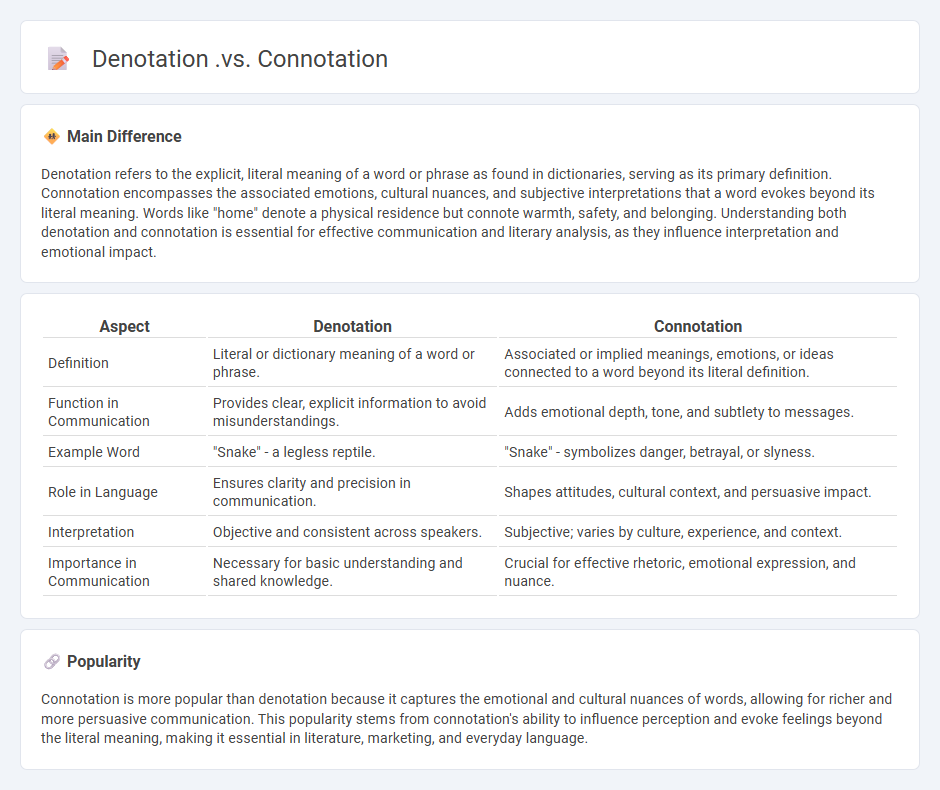
Denotation refers to the explicit, dictionary definition of a word, conveying its literal meaning without emotional or cultural associations. Connotation involves the implied or suggested meanings that go beyond the literal sense, often influenced by personal experiences, cultural context, and emotions. Explore how understanding the distinction between denotation and connotation enhances effective communication and nuanced interpretation.
Main Difference
Denotation refers to the explicit, literal meaning of a word or phrase as found in dictionaries, serving as its primary definition. Connotation encompasses the associated emotions, cultural nuances, and subjective interpretations that a word evokes beyond its literal meaning. Words like "home" denote a physical residence but connote warmth, safety, and belonging. Understanding both denotation and connotation is essential for effective communication and literary analysis, as they influence interpretation and emotional impact.
Connection
Denotation refers to the literal, dictionary definition of a word, while connotation involves the emotional or cultural associations attached to that word. Both elements work together to shape meaning, influencing how language is interpreted in different contexts. Understanding their connection enhances communication by revealing not just what words mean, but also the subtle implications they carry.
Comparison Table
| Aspect | Denotation | Connotation |
|---|---|---|
| Definition | Literal or dictionary meaning of a word or phrase. | Associated or implied meanings, emotions, or ideas connected to a word beyond its literal definition. |
| Function in Communication | Provides clear, explicit information to avoid misunderstandings. | Adds emotional depth, tone, and subtlety to messages. |
| Example Word | "Snake" - a legless reptile. | "Snake" - symbolizes danger, betrayal, or slyness. |
| Role in Language | Ensures clarity and precision in communication. | Shapes attitudes, cultural context, and persuasive impact. |
| Interpretation | Objective and consistent across speakers. | Subjective; varies by culture, experience, and context. |
| Importance in Communication | Necessary for basic understanding and shared knowledge. | Crucial for effective rhetoric, emotional expression, and nuance. |
Literal Meaning
Literal meaning in communication refers to the explicit, dictionary definition of a word or phrase as used in a message. It conveys the direct, surface-level information without interpretation or emotional nuance, ensuring clarity and precision. Understanding literal meaning is essential in contexts like legal documents, technical instructions, or formal communications to avoid ambiguity. Effective communication often begins with grasping this fundamental layer before exploring implied or contextual meanings.
Implied Meaning
Implied meaning in communication refers to the information or messages that are suggested but not explicitly stated by the speaker or writer. It relies on context, tone, body language, and shared knowledge between communicators to convey underlying intent or emotions. Understanding implied meaning enhances effective interpersonal communication by enabling listeners to interpret subtleties and unspoken nuances. This concept is critical in fields such as linguistics, psychology, and intercultural communication studies.
Contextual Interpretation
Contextual interpretation in communication involves understanding messages based on the situational factors, cultural background, and interpersonal relationships influencing the exchange. Effective communicators analyze verbal and nonverbal cues within the specific context, including environmental settings and social norms, to accurately decode meaning. This process reduces misunderstandings and enhances clarity by adapting interpretations to the audience's perspectives and contextual variables. Research from the Journal of Communication highlights that context-sensitive interpretation improves message reception and relational dynamics in diverse communication scenarios.
Emotional Associations
Emotional associations in communication play a crucial role in shaping how messages are perceived and interpreted by audiences. These associations influence audience engagement by triggering specific feelings such as trust, empathy, or excitement, thereby affecting message retention and response. Studies in communication theory show that emotional content can enhance persuasion and facilitate stronger connections between speakers and listeners. Effective use of emotional associations leverages tone, imagery, and word choice to create impactful and memorable communication experiences.
Message Ambiguity
Message ambiguity occurs when a communication contains multiple interpretations or unclear meanings, hindering effective information exchange. It often arises from vague language, cultural differences, or insufficient context, leading to misunderstandings. Reducing ambiguity involves using precise vocabulary, providing explicit explanations, and confirming message clarity through feedback. Effective communication strategies emphasize clarity to improve comprehension and minimize errors in various settings.
Source and External Links
Connotation vs Denotation -- Examples & Differences Explained - Denotation is the textbook or literal meaning of a word, while connotation is its subjective, emotional, or cultural associations.
Connotation vs. Denotation: Understanding Word Choice - Denotation refers to the dictionary definition of a word, and connotation refers to the feelings, ideas, or personal reactions that word evokes beyond its basic meaning.
Denotation And Connotation - Literal And Implied Meaning - Denotation is the first, literal level of meaning (what something is), and connotation is the implied, emotional, or cultural meaning that goes beyond the literal.
FAQs
What does denotation mean?
Denotation means the explicit, literal meaning of a word or phrase, without any emotional or cultural associations.
What does connotation mean?
Connotation means the subjective or emotional meaning associated with a word beyond its literal definition.
How do denotation and connotation differ?
Denotation is the literal, dictionary definition of a word, while connotation refers to the emotional or cultural associations and implied meanings that a word carries beyond its literal definition.
Can a word have the same denotation but different connotations?
A word can have the same denotation but carry different connotations depending on context, culture, or speaker perspective.
Why is connotation important in communication?
Connotation is important in communication because it influences the emotional response and interpretation of words, shaping how messages are received and understood beyond their literal meaning.
How does context affect connotation?
Context shapes connotation by influencing the emotional and cultural associations a word or phrase evokes in a specific situation.
How can connotation influence interpretation?
Connotation influences interpretation by adding emotional or cultural meanings to words beyond their literal definitions, shaping readers' or listeners' perceptions and reactions.
 calledges.com
calledges.com